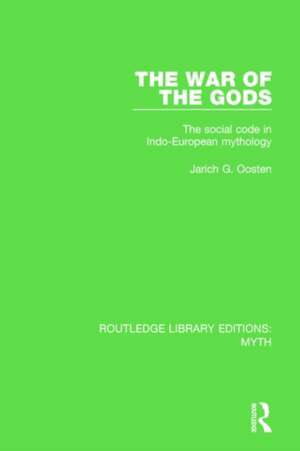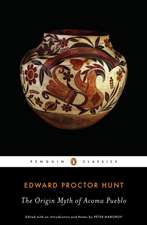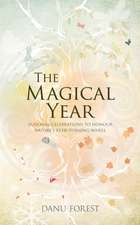The War of the Gods Pbdirect: The Social Code in Indo-European Mythology: Routledge Library Editions: Myth
Autor Jarich Oostenen Limba Engleză Hardback – 10 mar 2015
Dr Oosten describes how the ancient mythological cycles were broken down and transformed into heroic sagas and epics, and shows how many traditionally related themes – the severed head, the magic cauldron – were preserved. Gradually the political problems of kingship came to overshadow the social problems of kinship, as in the development of the myths of King Arthur. Dr Oosten argues that the social code remains basically the same, and his analysis of this code gives a fascinating perspective on the development of Indo-European mythology from the oldest written sources to the comparatively recent faitytales.
| Toate formatele și edițiile | Preț | Express |
|---|---|---|
| Paperback (1) | 296.19 lei 6-8 săpt. | |
| Taylor & Francis – 26 sep 2016 | 296.19 lei 6-8 săpt. | |
| Hardback (1) | 707.74 lei 6-8 săpt. | |
| Taylor & Francis – 10 mar 2015 | 707.74 lei 6-8 săpt. |
Preț: 707.74 lei
Preț vechi: 1069.34 lei
-34% Nou
Puncte Express: 1062
Preț estimativ în valută:
135.43€ • 144.82$ • 112.92£
135.43€ • 144.82$ • 112.92£
Carte tipărită la comandă
Livrare economică 17 aprilie-01 mai
Preluare comenzi: 021 569.72.76
Specificații
ISBN-13: 9781138840669
ISBN-10: 1138840661
Pagini: 194
Dimensiuni: 156 x 234 x 15 mm
Greutate: 0.41 kg
Ediția:1
Editura: Taylor & Francis
Colecția Routledge
Seria Routledge Library Editions: Myth
Locul publicării:Oxford, United Kingdom
ISBN-10: 1138840661
Pagini: 194
Dimensiuni: 156 x 234 x 15 mm
Greutate: 0.41 kg
Ediția:1
Editura: Taylor & Francis
Colecția Routledge
Seria Routledge Library Editions: Myth
Locul publicării:Oxford, United Kingdom
Cuprins
1. The Structural Analysis of Myth 1.1. The Nature of Myths 1.2. Time and History 1.3. Understanding Myths 1.4. Myth and the Cultural Order 1.5. Problems of Method 2. Indo-European Cultures as a Field of Ethnological Study 2.1. The Social Organization of Indo-European Society 2.2. Social Stratification and the Political Order 2.3. The Indo-European Pantheon 3. The Wars of the Gods in Scandinavian Mythology 3.1. The Scandinavian Pantheon in Icelandic Sources 3.2. The War Between the Giants and the Gods 3.3. The War Between the Aesir and the Vanir 3.4. Ragnarok 4. The Cycle of the Mead 4.1. The Feast of Immortality 4.2. The Origin of the Mead 4.3. Sharing the Mead 4.4. The Lure of Consumption 4.5. The Bird and the Snake 5. The Magic Cauldron 5.1. The Sons of Tuirill Biccreo 5.2. The Death of Cu Roi 5.3. The Second Branch of the Mabinogion 5.4. The Magic Cauldron 5.5. The Iron House 6. The Severed Head 6.1. Dionysos 6.2. Pallas Athena 6.3. The Capture of the Mead 6.4. The Head of the Gorgo 6.5. The Labours of Herakles 6.6. The Voyage of the Argo 7. The Battles of Mag Tured 7.1. The Six Immigrants 7.2. The First Battle of Mag Tured 7.3. The Second Battle of Mag Tured 7.4. Problems of Succession 7.5. The First Kings of the Tuath De Danann 8. The Roman Kings 8.1. The Foundation of Rome 8.2. Romans and Sabines 8.3. The Tarquinian Dynasty 9. The Unworthy King 9.1. The Medieval Epics 9.2. Arthur and the Round Table 9.3. Charlemagne 9.4. The Fairy-Tales 9.5. The Development of Indo-European Mythology
Descriere
This structural analysis of myth, first published in 1985, focuses on social and political problems of Indo-European mythology. Dr Jarich Oosten tells how the ancient Indo-European gods competed for supreme power and the exclusive possession of the sacred potion of wisdom and immortality. In examining the social code of the wars of the gods, he reveals that there are remarkably consistent patterns in time and space: paternal relatives, equals at first, prove unable to share power, magic goods, etc; while some gods retain their divine status as an exclusive prerogative, their brothers or paternal cousins are transformed into demons; relatives by marriage, however, who are unequal at first, succeed in sharing power and magic goods, and thus become equal partners in the pantheon.
Dr Oosten describes how the ancient mythological cycles were broken down and transformed into heroic sagas and epics, and shows how many traditionally related themes – the severed head, the magic cauldron – were preserved. Gradually the political problems of kingship came to overshadow the social problems of kinship, as in the development of the myths of King Arthur. Dr Oosten argues that the social code remains basically the same, and his analysis of this code gives a fascinating perspective on the development of Indo-European mythology from the oldest written sources to the comparatively recent faitytales.
Dr Oosten describes how the ancient mythological cycles were broken down and transformed into heroic sagas and epics, and shows how many traditionally related themes – the severed head, the magic cauldron – were preserved. Gradually the political problems of kingship came to overshadow the social problems of kinship, as in the development of the myths of King Arthur. Dr Oosten argues that the social code remains basically the same, and his analysis of this code gives a fascinating perspective on the development of Indo-European mythology from the oldest written sources to the comparatively recent faitytales.














